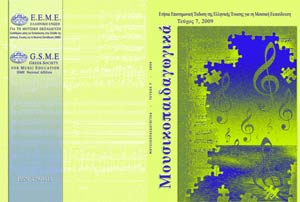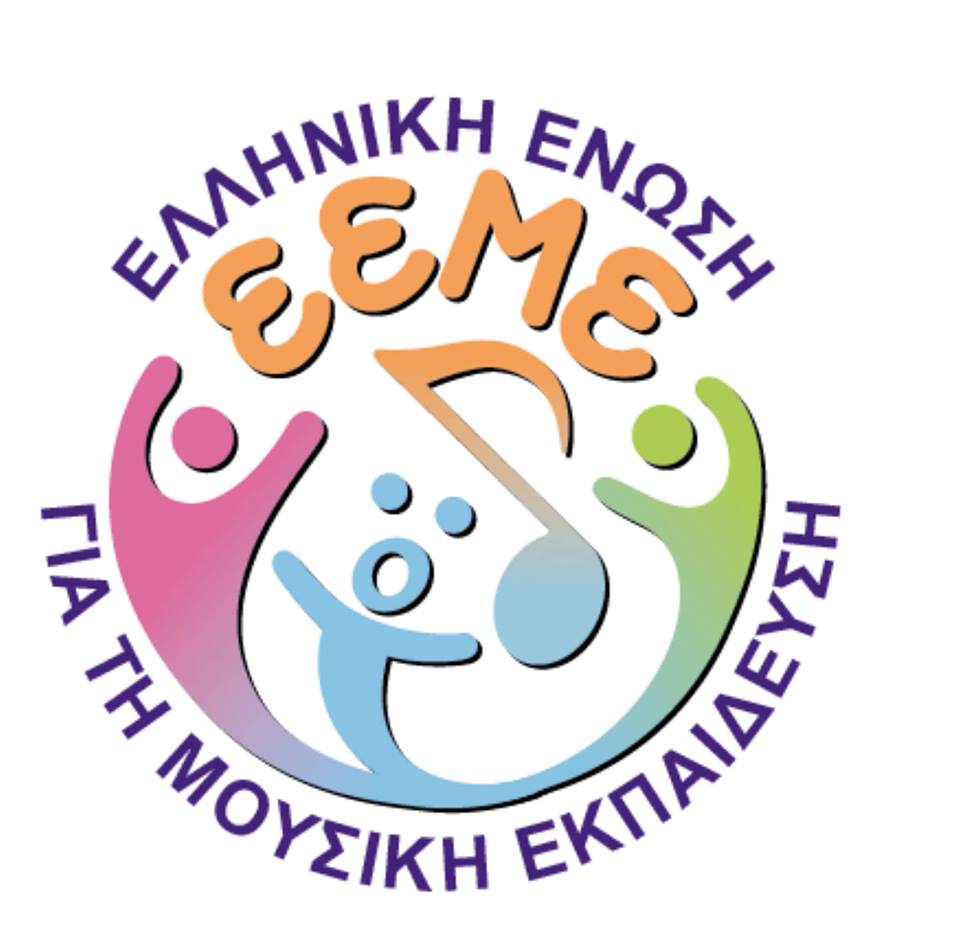
Editorial
1) Athina Kteniadaki: Music in Greek General Secondary Education: Music teachers' attitudes and opinions (p.p. 5 - 33)
2) Marina Sotiropoulou-Zorbala: Pedagogical and aesthetic criteria for the selection and processing of songs in kindergarten and elementary education: Songs for the 'colors' (p.p. 34 - 52)
3) May Kokkidou & Xanthoula Papapanagiotou: Critical thinking and music education (p.p. 53 - 72)
4) Helen Tsakiridou & May Kokkidou: Investigation into the relationship between music education and the development of self-perception and self-esteem in childhood (p.p. 73 - 93)
5) Dimitra Koniari: The perceptual organization of the piece XXXVII from the ''4 Greek miniatures for piano''by Yannis Constantinidis, by adult listeners with or without explicit musical training (94 - 107)
Abstracts:
1) Athina Kteniadaki
Music in Greek General Secondary Education: Music teachers' attitudes and opinions
The present study aimed at investigating General Secondary Music Teachers' opinions, professional profile, instructive approaches and the conditions that they encounter in school contexts. The innovational aspect of this study relies on the fact that there hasn't been any other similar study, of such content and range, concerning music instruction in Greek Secondary Education. The final sample of this empirical study constituted of 163 music teachers, who worked in 26 different geographical regions of Greece, and who anonymously completed a questionnaire that had been sent to them. The present study took place during spring time in the year 2007 in partial fulfilment of the requirements for the Master in School Pedagogy, from the Department of Philosophy and Pedagogy, Aristotle University of Thessaloniki.
2) Marina Sotiropoulou-Zorbala
Pedagogical and aesthetic criteria for the selection and processing of songs in kindergarten and elementary education: Songs for the 'colors'
Under what criteria does teachers, general or art specialist, select the stimuli on which to base an Aesthetic -specifically, a musical- education? Which songs do they choose to teach? Also, how do they process their musical choices? This paper attempts to describe the criteria of a possible approach that primary-school teachers could adopt for the pedagogical evaluation of songs. Starting from the premise that the strictly musicological criteria are necessary but not sufficient, the need is stressed to complement them with educational and aesthetic ones which seem to be overlooked as a rule. Examples are given to analyze ways of selecting and managing songs in the classroom. The paper starts with giving reasons and ways for general or music specialist educators, to treat songs as a field for children to assimilate the subjects they are taught. It then provides arguments and models for activities which lead the teacher to resort to the various axes of aesthetic theory in search of selection filters and ways of processing the songs which he or she allow through the sacred threshold of the classroom. The ultimate aim is to highlight a fact which seems self-evident yet is invariably betrayed in everyday school practice: the potentially crucial role of aesthetic research and theory in the implementation of an aesthetic education.
3) May Kokkidou & Xanthoula Papapanagiotou
Critical thinking and music education
In recent years, researchers in the fields of Pedagogy and Education have stressed out the importance of critical thinking in the development of higher mental functions and in the formation of learning strategies. As a result, latest curricula focus on activities that are considered to contribute to the development of critical thinking. Critical thinking is considered to have an important role in the field of artistic/aesthetic education in general and in the field of music education in particular. Critical thinking skills are directly related to creativity and to tendency for exploration which, in turn, characterize all artistic activities. Additionally, critical thinking skills, as they are pursued in the field of music education, form a cross-curricular frame for the acquisition of new knowledge. In this paper we discuss the terminology related to critical thinking and we focus on the role of critical thinking in the teaching-learning process, especially in the context of music teaching and learning. Finally, we present strategies that might be followed and applied in music teaching and learning which may contribute to the development of students critical thinking.
4) Helen Tsakiridou & May Kokkidou
Investigation into the relationship between music education and the development of self-perception and self-esteem in childhood
Music is an activity in which humans are involved actively-consciously as well as sub-consciously, emotionally and mentally; it is a special way of understanding ourselves and our environment, interacting socially and acting creatively. Many researchers have deduced that people involved consciously and systematically in music do so because it makes them feel emotional fulfillment and elevates their self-esteem. The present research attempts to explore the relationship between music education and the development of self-perception and self-esteem in primary school students. The research was conducted on 1113 5th and 6th grade students differentiated in sex (boys-girls) and music education status (studying music or not). The Harper (1985) questionnaire was used - adjusted for Greek students - which includes six evaluation scales, five related to self-perception and one to self-esteem. The data analysis revealed that the areas of self-perception affected by the music education variable are school ability, conduct/behavior and overall self-esteem. Non-studying-music children tended to have better self-esteem regarding their athletic ability in relation to music educated ones. No significant statistical deviation was noticed between students of the 5th or 6th grade.
5) Dimitra Koniari
The perceptual organization of the piece XXXVII from the "4 Greek miniatures for piano'' by Yannis Constantinidis, by adult listeners with or without explicit musical training
The experimental procedure of segmentation of the musical discourse is used in order to be investigated the influence of explicit musical training in the perceptual grouping of a music piece. The results show that musicians (listeners with explicit musical training) are more consistent in their segmentation process than non-musicians (listeners without explicit musical training), and seem to process music information using cues related to the hierarchies established by the tonal system. On the other hand, non-musicians seem to segment the musical discourse relying more on cues related to acoustic characteristics of the musical surface, such as discontinuities and differences in pitch, loudness and duration. However, mere exposure to music and implicit musical learning can also influence the segmentation performance of non-musicians, leading them to respond to music as musically trained listeners do.





 Please wait...
Please wait...